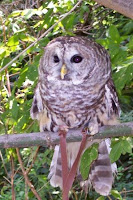At John James Audubon State Park we are fortunate to have education raptors who help us reinforce important wildlife concepts. We do quite a few raptor programs during the course of a year to people of all ages. As a result, we usually can predict the types of questions that visitors are curious about. I thought our reading visitors would like a glimpse into working with one of our top-level predators…our birds of prey.
Our raptors eat meat…just like in the wild. Unlike their free cousins, our animals don’t have to kill anything. They still retain their wicked, quick reflexes during meal time so we always take special care whenever we handle them.
 |
| Reddy |
We hold the birds pretty close to us, are we afraid of being attacked? Not usually, but we’re always aware of the comfort level of the animals. If the animals are stressed or scared, that’s when they’re more likely to try to escape. When we work with the raptors we want them to feel safe and protected while in our hands so we may be a bit protective about people getting too close. We read their body language – their head, neck, leg and wing posturing, their gaze, and their grip all give us an idea of their mood and stress level. These animals were once wild animals. No amount of working with them will change their wild instincts. Never underestimate the power of instincts and genetics.
 |
| Scarlett |
Our oldest residential raptor is Reddy, our skittish male red-tailed hawk who came to J. J. Audubon State Park in 1992. He, like our 8 yr old female red-tailed hawk Scarlett (nicknamed “the bottomless pit”), has a badly broken wing that can’t be repaired. They are non-releasable and will spend the rest of their days at the park. I can’t tell you how Reddy was injured but I’m guessing that Scarlett met with a moving vehicle because she was found in a ditch.
 |
| Boo |
Our newest addition, a barred owl named Boo, is a strange little guy. Topping out at about 1 pound 10 ounces, Boo has a badly deformed foot which would prevent him from properly hunting and defending himself in the wild. Whether this was a birth defect or caused by some sort of youth injury, he has adapted well to park life. He even has a wild barred owl girlfriend who comes to call from time to time.
Do animals have different personalities? Definitely! For whatever reason, our birds of prey prefer women handlers. Scarlett is a child in a grown-up body. She squeaks/begs like a child and responds well to structure and rules wanting just to please others. She is, however, completely oblivious to her own strength especially when getting on the glove. She lands as gently as a falling brick and hangs on to our gloved hand with a death-grip. Reddy, by comparison, is very aware of his strength and lands on a gloved hand very gently. However, don’t underestimate Reddy. When overly irritated, Reddy knows where the nerves in our hands are and will not hesitate to apply more than sufficient pressure to satisfy his needs.
Do the animals hurt us? Well, I think the person most hurt by our raptors is Museum Curator, Alan Gehret who sticks his fingers around the birds’ heads and inside the corners of the birds’ mouths when we shape/grind their beaks with a dremel tool. This grooming is not necessary for wild birds but essential for captive ones. Our birds don’t like it and have no problem letting Alan know.
Working with top-level predators is a lot of fun but takes work to be safe and maintain control